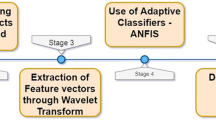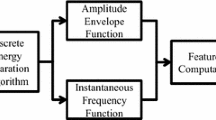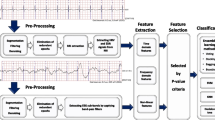Abstract
An automated sleep staging based on analyzing long-range time correlations in EEG is proposed. These correlations, indicating time-scale invariant property or self-similarity at different time scales, are known to be salient dynamical characteristics of stage succession for a sleeping brain even when the subject suffers a destructive disorder such as Obstructive Sleep Apnea (OSA). The goal is to extract a set of complementary features from cerebral sources mapped onto the scalp electrodes or from a number of denoised EEG channels. For this purpose, source localization/extraction and noise reduction approaches based on Independent Component Analysis were used prior to correlation analysis. Feature extracted segments were then classified in one of the five classes including WAKE, STAGE1, STAGE2, SWS and REM via an ensemble neuro-fuzzy classifier. Some techniques were employed to improve the classifier’s performance including Scaled Conjugate Gradient Method to speed up learning the ANFIS classifiers, a pruning algorithm to eliminate irrelevant fuzzy rules and the 10-fold cross-validation technique to train and test the system more efficiently. The performance of classification for two strategies including (1) feature extraction from effective cerebral sources and (2) feature extraction from selected channels of denoised EEG signals was compared and contrasted in terms of training errors and test accuracies. The first and second strategies achieved 92.23 and 88.74% agreement with human expert respectively which indicates the effectiveness of the staging system based on cerebral sources of activity. Our results further indicate that the misclassification rates were almost below 10%. The proposed automated sleep staging system is reliable due to the fact that it is based on the underlying dynamics of sleep staging which is less likely to be affected by sleep fragmentations occurred repeatedly in OSA.





Similar content being viewed by others
Notes
Rechtschaffen and Kales manual sleep scoring.
American Academy of Sleep Medicine.
Stages 3 and 4 were pooled together as slow wave sleep (SWS).
References
Stickgold R, Walker MP (2005) Memory consolidation and reconsolidation: what is the role of sleep? Trends Neurosci 28:408–415
Raiesdana S (2017) Quantifying the dynamic of OSA brain using multifractal formalism: A novel measure for sleep fragmentation. Technol Health Care 25:265–284
Hsu YL, Yang YT, Wang JS, Hsu CY (2013) Automatic sleep stage recurrent neural classifier using energy features of EEG signals. Neurocomputing 104:105–114. https://doi.org/10.1016/j.neucom.2012.11.003
Liang SF, Kuo CE, Hu YH, Pan YH, Wang YH (2012) Automatic stage scoring of single-channel sleep EEG by using multiscale entropy and autoregressive models. IEEE Trans Instrum Meas 61(6):1649–1657. https://doi.org/10.1109/TIM.2012.2187242
Şen B, Peker M, Çavuşoğlu A, Çelebi FV (2014) A comparative study on classification of sleep stage based on EEG signals using feature selection and classification algorithms. J Med Syst 38(3):1–21. https://doi.org/10.1007/s10916-014-0018-0
Tsinalis O, Matthews PM, Guo Y (2015) Automatic sleep stage scoring using time-frequency analysis and stacked sparse autoencoders. Ann Biomed Eng. https://doi.org/10.1007/s10439-015-1444-y
Lajnef T, Chaibi S, Ruby P, Aguera PE, Eichenlaub JB, Samet M, Jerbi K (2015) Learning machines and sleeping brains: automatic sleep stage classification using decision-tree multi-class support vector machines. J Neurosci Methods 250:94–105. https://doi.org/10.1016/j.jneumeth.2015.01.022
Liang SF, Kuo CE, Shaw FZ, Chen YH, Hsu CH, Chen JY (2015) Combination of expert knowledge and a genetic fuzzy inference system for automatic sleep staging. IEEE Trans Biomed Eng. https://doi.org/10.1109/TBME.2015.2510365
Virkkal J, Hasan J, Varri A, Himanen S-L, Müller K (2007) Automatic sleep stage classification using two-channel electro-oculography. J Neurosci Methods 166(1):109–115
Uchida S, Matsuura M, Ogata S, Yamamoto T, Aikawa N (1996) Computerization of Fujimori’s method of waveform recognition, a review and methodological considerations for its application to all-night sleep EEG. J Neurosci Methods 64:1–12
Liu Y, Yan L, Zeng B, Wang W (2010) Automatic sleep stage scoring using Hilbert-Huang transform with BP neural network. In Proceedings of 4th international conference on bioinformatics and biomedical engineering (iCBBE) pp 1–4
Doroshenkov LG, Konyshev VA, Selishchev SV (2007) Classification of human sleep stages based on EEG processing using hidden Markov models. Biomed Eng 41(1):25–28. https://doi.org/10.1007/s10527-007-0006-5
Güneş S, Polat K, Yosunkaya Ş (2010) Efficient sleep stage recognition system based on EEG signal using k-means clustering based feature weighting. Expert Syst Appl 37(12):7922–7928. https://doi.org/10.1016/j.eswa.2010.04.043
Yaghouby F, Sunderam S (2015) Quasi-supervised scoring of human sleep in polysomnograms using augmented input variables. Comput Biol Med 59:54–63. https://doi.org/10.1016/j.compbiomed.2015.01.012
Yuan JW, Zheng B, Pan CP, Wu YZ, Trimper S (2006) Dynamic scaling behavior of human brain electroencephalogram. Physica A 364:315–323
Linkenkaer-Hansen K, Nikouline VV, Palva JM, Ilmoniemi RJ (2001) Long-range temporal correlations and scaling behavior in human brain oscillations. J Neurosci 21(4):1370–1377
Lo CC, Chou T, Penze T (2004) Common scale-invariant patterns of sleep–wake transitions across mammalian species. Proc Natl Acad Sci USA 101(50):17545–17548
Lo CC, Amaral LA, Havlin S (2002) Dynamics of sleep-wake transitions during sleep. Europhys Lett 57(5):625–631
Goldberger AL, Amaral L, Hausdorff JM, Ivanov PC, Peng CK, Stanley HE (2002) Fractal dynamics in physiology: alterations with disease and aging. Proc Natl Acad Sci 99(Suppl. 1):2466–2472
Weiss B (2010) Self-organized criticality of the brain: fractal analysis of the human sleep EEG. Ph.D. dissertation, Pázmány Péter Catholic University, Budapest
Tang WC, Lu SW, Tsai CM, Kao CY, Lee HH (2007) Harmonic parameters with HHT and wavelet transform for automatic sleep stages scoring. World Acad Sci Eng Technol 33:176–179
Subasi A, Kiymik M, Akin M (2005) Automatic recognition of vigilance state by using a wavelet-based artificial neural network. Neural Comput Appl 14:45–55
Kurt M, Sezgin N, Akin M, Kirbas G, Bayram M (2009) The ANN-based computing of drowsy level. Expert Syst Appl 36(2):2534–2542
Jo HG, Park JY, Lee CK, An SK, Yoo SK (2010) Genetic fuzzy classifier for sleep stage identification. Comput Biol Med 40(7):629–634. https://doi.org/10.1016/j.compbiomed.2010.04.007
Flexer A, Dorffner G (2002) An automatic, continuous and probabilistic sleep stager based on a hidden Markov model. Appl Artif Intell 16(3):199–207
Garg G, Singh V, Gupta JRP, Mittal AP, Chandra S (2011) Computer assisted automatic sleep scoring system using relative wavelet energy based neuro fuzzy model. WSEAS Trans Biol Biomed 8:12–24
Khasawneh N, Jaradat MAK, Fraiwan L, Al-Fandi M (2011) Adaptive neueo-fuzzy inference system for automatic sleep multistage level scoring employed EEG, EOG, and EMG extracted features. Appl Artif Intell 25:163–179
Shannon CE (1948) A mathematical theory of communication. Bell Syst Tech J 27:379–423
Linkenkaer-Hansen K (2002) Self-organized criticality and stochastic resonance in the human brain, PhD thesis, Helsinki University of Technology
Rodríguez-Sotelo JL, Osorio-Forero A, Jiménez-Rodríguez A, Cuesta-Frau D, Cirugeda-Roldán E, Peluffo D (2014) Automatic sleep stages classification using eeg entropy features and unsupervised pattern analysis techniques. Entropy 16:6573–6589. https://doi.org/10.3390/e16126573
Mallat M, Hwang L (1992) Singularity detection and processing with wavelets. IEEE Trans Information Theory 38(2):617–642
Yildiz A, Akin M, Poyraz M, Kirbas G (2009) Application of adaptive neuro-fuzzy inference system for vigilance level estimation by using wavelet-entropy feature extraction.” Expert Syst Appl 36(4):7390–7399
Cetişli B, Barkana A (2010) Speeding up the scaled conjugate gradient algorithm and its application in neuro-fuzzy classifier training. Soft Comput 14(4):365–378
Held CM, Heiss JE, Estévez PA, Perez CA, Garrido M, Algarín C, Peirano P (2006) Extracting fuzzy rules from polysomnographic recordings for infant sleep classification. IEEE Trans Biomed Eng 53(10):1954:1962
Acknowledgements
This work is supported by Qazvin Islamic Azad University (QIAU). The author thanks a lot to Dr. Soleyman Esmaeilzadehha for his long term collaboration and to Dr. Khosro Sadeghniiat, the head of occupational sleep research center in Baharloo hospital, Tehran, Iran. Data for this study was recorded and reviewed under his supervision in that center.
Author information
Authors and Affiliations
Corresponding author
Ethics declarations
Conflict of interest
The author has no conflicts of interest.
Ethical approval
Research Grant has been received by author from her affiliation; i.e. the QIAU University. The study has been approved by the national research ethics committee and all procedures performed in the study involving human participants have been performed in accordance with the local ethical standards.
Informed consent
Informed consent was obtained at the clinic from all individual participants included in the study.
Appendix
Appendix
The algorithm of WTMM method to find the singularity spectrum consists of the following steps:
-
A set of lines of local modulus maxima of the wavelet coefficients, L(a), is found at each scale a.
-
The partition functions are calculated by the sum of the power of order q of the modulus maxima of the wavelet coefficients along each line at the scales smaller than the given value a,
$$Z(q,a)=\sum\limits_{{l \in L({a^*})}} {{{\left( {{{\sup }_{a \leq a}}|W({a^*},{b_l}({a^*})|} \right)}^q}}$$(11)where \({b_l}({a^*})\) determines the position of the maximum corresponding to the line l at each scale.
-
As \(a \to 0\) (small scales), the partition function shows the power low behavior, \(Z(q,a)={a^{\tau (q)}}\). Now, the scaling exponent \(\tau (q)\) can be extracted as the slope of a log–log plot of the partition function versus the scale a; \({{\tau (q) = \log _{{10}} Z(q,a)} \mathord{\left/ {\vphantom {{\tau (q) = \log _{{10}} Z(q,a)} {\log _{{10}} a}}} \right. \kern-\nulldelimiterspace} {\log _{{10}} a}}\).
-
A regression is then adopted to estimate \(\tau (q)\) as a linear function of q for monofractal signals,\(\tau (q)=qh(q) - 1\), where \(h(q)=d\tau (q)/d(q)=const\) is the global Hurst exponent. For multifractals,\(\tau (q)\) is a nonlinear function, \(\tau (q)=qh(q) - D(h)\), with a large number of Holder exponents describing local scaling of the wavelet coefficients.
-
The singularity spectrum (distribution of local exponents) can be expressed using a Legendre transform \(D(h)=qh(q) - \tau (q)\) which quantifies the statistical properties of the different subsets characterized by different exponents [30]. An example of local maxima lines determination by WTMM method for a 30s sleep EEG segment is show in Fig. 6.
Rights and permissions
About this article
Cite this article
Raiesdana, S. Automated sleep staging of OSAs based on ICA preprocessing and consolidation of temporal correlations. Australas Phys Eng Sci Med 41, 161–176 (2018). https://doi.org/10.1007/s13246-018-0624-0
Received:
Accepted:
Published:
Issue Date:
DOI: https://doi.org/10.1007/s13246-018-0624-0





